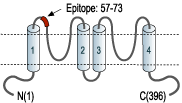Overview
- Peptide (C)DDYQQLELVILQSEPHR, corresponding to amino acid residues 57-73 of rat KCNK9 (accession number Q9ES08). Extracellular, near the P1 loop.

 Western blot analysis of KCNK9 in rat cerebellum (lanes 1, 4), human mammary gland MCF-10A (lanes 2, 5) and MCF-7 (lanes 3, 6) cell lysates (upper panel):1-3. Anti-KCNK9 (TASK-3) (extracellular) Antibody (#APC-044).
Western blot analysis of KCNK9 in rat cerebellum (lanes 1, 4), human mammary gland MCF-10A (lanes 2, 5) and MCF-7 (lanes 3, 6) cell lysates (upper panel):1-3. Anti-KCNK9 (TASK-3) (extracellular) Antibody (#APC-044).
4-6. Anti-KCNK9 (TASK-3) (extracellular) Antibody, preincubated with KCNK9/TASK-3 (extracellular) Blocking Peptide (#BLP-PC044).
Lower panel: anti-β actin to ensure equal loading.
Note that the expected 50 kD MW band is present in cerebellum and in the tumorigenic breast cancer cell line (MCF-7) but not in the non-tumorigenic breast cell line (MCF-10A). Western blot analysis of rat cerebellum lysate:1. Anti-KCNK9 (TASK-3) (extracellular) Antibody (#APC-044), (1:200).
Western blot analysis of rat cerebellum lysate:1. Anti-KCNK9 (TASK-3) (extracellular) Antibody (#APC-044), (1:200).
2. Anti-KCNK9 (TASK-3) (extracellular) Antibody, preincubated with the control peptide antigen.
- Rat brain sections (Okamoto, K. et al. (2016) eNeuro 3, e0138-16.2016.).
- Lesage, F. and Lazdunski, M. (2000) Am. J. Physiol. Renal Physiol. 279, F793.
- Patel, A.J. et al. (2001) Trends Neurosci. 24, 339.
- Mu, D. et al. (2003) Cancer Cell 3, 297.
- Lauritzen, I. et al. (2003) J. Biol. Chem. 278, 232068.
KCNK9 (also named TASK3 or K2P9.1) is a member of the 2-pore (2P) domain K+ channels family that probably assemble as dimers to constitute a functional channel.1 These channels show little time- or voltage-dependence and are considered to be “leak” or “background” K+ channels, thereby generating background currents which help set the membrane resting potential and cell excitation.
The channels are regulated by diverse physical and chemical stimuli including temperature, pH, mechanical stretch, inhalation anesthetics, etc.2 The physiological role of the K2P channels is not yet clear, though they were proposed to participate in breathing, aldosterone secretion and anesthetic-mediated neuronal activity.
In human, expression of KCNK9 is restricted in brain and its expression overlaps with the structurally related KCNK3 (TASK1, K2P3.1) channel. In rat, it is more widely expressed in other tissues as well as in brain.
Unexpectedly, KCNK9 was found to be over-expressed between 5 to 100-fold in 44% of breast cancer tumors tested.
Transfection and over-expression of KCNK9 in cell lines promotes tumor growth and confers resistance to hypoxia and serum deprivation.3 Recently, KCNK9 was found to play an important role in K+-dependent apoptosis of cerebellar granules.4
Application key:
Species reactivity key:
Anti-KCNK9 (TASK-3) (extracellular) Antibody (#APC-044) is a highly specific antibody directed against an epitope of the rat protein. The antibody can be used in western blot and immunohistochemistry applications. The antibody recognizes an extracellular epitope and is thus ideal for detecting the channel in living cells. It has been designed to recognize TASK-3 from rat and human samples.
Applications
Citations
- Rat brain sections.
Okamoto, K. et al. (2016) eNeuro 3, e0138-16.2016.
- Innamaa, A. et al. (2013) Anticancer Res. 33, 1401.
- Brenner, A. et al. (2008) Am. J. Physiol. Endocrinol. Metab. 295, E1480.
- Burdakov, D. et al. (2006) Neuron 50, 711.
- Pocsai, K. et al. (2006) Cell. Mol. Life Sci. 63, 2364.
- Kovacs, I. et al. (2005) Virchows Arch. 446, 402.
